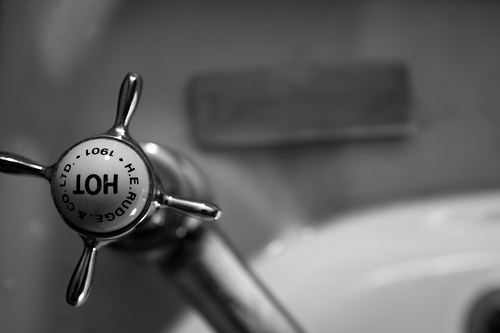Lead is vicious stuff. When inhaled or ingested, your body can’t tell the difference between lead and calcium, so it tucks lead away in your bones — making the bones weaker and being sucked back out into the bloodstream when the body is looking for calcium. Lead in the bloodstream can reduce a child’s IQ. Reducing lead levels in children provides $213 billion in economic benefits per year. There have even been studies suggesting a correlation between reductions in lead levels and drops in crime rates.
We’ve nearly eliminated lead from all gasoline and removed it from paint — two of the most common sources of it 40 years ago. But American University and NBC News found another common vector that’s still in place: water systems.

Photo by Nic McPhee.
The problem stems, ironically, from the EPA’s efforts to remove lead pipes from water conduits. The 1991 Lead and Copper Rule required that utilities test home water systems. If samples exceeded a certain level of lead, the utility had to reduce lead in the water either through a chemical process or by replacing lead service lines. That latter instance, in “partial pipe replacements,” is where the problem arose.
The regulation began to derail as early as 1993, when the American Water Works Association (AWWA), which represents more than 4,000 public and privately owned water systems, sued EPA. The trade group argued that EPA had adopted the Lead and Copper Rule without proper notice about how it planned to define “control” of — responsibility for — the service lines. The group also claimed that utilities did not have authority to replace the sections of lines on private property, and that ordering them to do so exceeded EPA’s mandate. …
[T]he agency amended its rule in 2000 to permit the utilities to perform so-called “partial pipe replacements,” from the water main to the private property line. In the vast majority of cases, homeowners would be responsible for paying to finish the job.
Few homeowners have done so, to their detriment.
The utility will pay for pipe replacement from the water plant to the street, but homeowners are supposed to replace the rest. This saves the utility money, but it means that the entire lead-lined system isn’t replaced in one go. The problem isn’t lead leaching from the remaining pipes, it’s that lead fragments have been shaken free and remain in the system, making it more likely that you’ll end up with lead in your drinking glass. Homeowners with lead paint can pay to have the paint removed, or can be diligent about cleaning up chips and fragments that flake off. (Children like to put lead paint fragments in their mouths, because lead tastes sweet.) But if the fragments are in the water system, they stay there.
The EPA has been considering how to address the problem and is scheduled to issue a revised rule next January. An obvious measure is to eliminate partial pipe replacements — which would generally mean that the utility would take responsibility for replacing the entire conduit. Needless to say, the utilities aren’t happy about the prospect of incurring that additional cost.
[F]aced with the prospect of new EPA rules, and increasing evidence that the partial pipe replacements pose a hazard, water utilities have developed a new tactic: “gifting” the lead service lines to property owners.
If the EPA says, “Replace everything you own,” the utilities can say, “Will do!” — and keep doing the same old thing, just replacing pipe up to the edge of homeowners’ property lines and claiming homeowners own the rest.
This is not an acceptable way to solve the problem, of course, given that it doesn’t solve the problem. There will be complaints about cost, and about efficacy — exactly as there were during the phaseout of lead in gasoline. At that point, we made the decision that children’s health superseded the concerns of fuel providers; now, we should decide that it’s worth utilities incurring higher costs.




